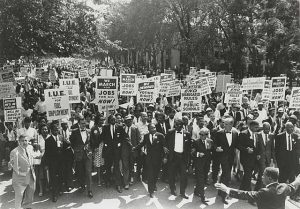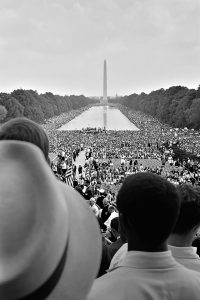


This photograph was taken on August 28, 1963, in Washington, D.C., during a notorious Civil Rights protest called the March on Washington[1]. As depicted in the photograph, thousands of people gathered to march. Many of these people were activists coming from organizations like, “the Southern Christian Leadership Conference (SCLC), the National Association for the Advancement of Colored People (NAACP), the Congress of Racial Equality (CORE) , the Student Nonviolent Coordinating Committee (SNCC) , and the National Urban League (NUL)”[2]. Others arrived “in busloads … from historically black colleges and universities”[3]. Although the march was dedicated to civil rights for African Americans, the marchers were joined by members of both the black and white communities. Among the many marchers a few historically famous individuals spoke at the march including the memorable Martin Luther King Jr. This march was meant to symbolize the unity of America and demonstrate that all Americans black or white are equal brothers and sisters. Through this symbolic protest the goal was to end racial segregation, gain voting rights, and obtain fair jobs and housing for African Americans.
American society in the 1960s was shaped by the postwar era from the Second World War. The postwar era involved, “the mass migration of rural southern Blacks to cities in the North, Midwest, and West”[4]. African Americans were seeking new lives escaping the Jim Crow laws of the south. These laws were put in place as a means of controlling the Black community of the south. They ranged anywhere from restrictions on voting, limited education, and even restricted marriage. Many of them were “in search of better jobs and housing, higher wages, and greater civil rights”[5]. This era of seeking rights by the African American community and many other groups would later be known as the Civil Rights Movement. The Civil Rights Movement centered around attaining equal rights for the discriminated groups in America; among them was the African American community. The March on Washington was one of the many events protesting discrimination and inequality.
Photographs like this one were taken to capture a single moment of history to reflect on years and decades later. Those who were unable to attend the march would now be able to utilize images rather than imagination and words to gather importance, experience, and significance of the event. The angle which the unknown author chose to capture demonstrates depth in a magnificent way. Any other angle would have drastically changed the perception of the amount of people attending the march. Even though this photograph does not capture every person in attendance it is clear that thousands filled the walkways leading up to the Washington Monument.
Initially this protest was questioned by former president John F. Kennedy, due to concerns of violence. However Philip Randolph, one of the leaders of the march explained, “if those dedicated to nonviolence were not allowed to lead the march, other, more militant activists would”[6]. It was after this conversation that the president approved the march. Along with thousands of marchers several activists spoke at the protest, one of them being Martin Luther King Jr. This protest is where Dr. King gave his infamous I Have a Dream Speech detailing “his “dream” that one day Black children and White children would “ ‘walk together as sisters and brothers’ ”[7].
The significance of this march was the way it captured audiences from all around the world. Through images, broadcasting, and the radio, “people in many nations would take up the cause of the American civil rights movement”[8]. The March on Washington symbolized global unity against racial segregation and discriminatory laws. This protest is still remembered and recognized today in American history.
[1] Wikimedia Commons, Civil Rights March on Washington D.C. (A wide-angle view of marchers along the mall, showing the Reflecting Pool and the Washington Monument), https://commons.wikimedia.org/wiki/File:Civil_Rights_March_on_Washington,_D.C._(A_wide-angle_view_of_marchers_along_the_mall,_showing_the_Reflecting_Pool_and…_-_NARA_-_542045.tif, accessed October 5, 2024.
[2] Peter B. Levy, “March on Washington,” Salem Press Encyclopedia, (2023). https://research.ebsco.com/c/dq7v4l/viewer/html/lesqdttwbv
[3] “45 Years Age: A. Philip Randolph’s 1963 March on Washington,” The Journal of Blacks in Higher Education, Number 60 (2008): 5. http://www.jstor.org/stable/40407148.
[4] David E. Shi, America: A Narrative History (W.W. Norton and Company, 2022), 1147.
[5] Ibid., 2.
[6] Peter B. Levy, “March on Washington,” Salem Press Encyclopedia, (2023). https://research.ebsco.com/c/dq7v4l/viewer/html/lesqdttwbv
[7] Ibid., 2.
[8] Mary L. Dudziak, “The 1963 March on Washington: At Home and Abroad,” Revue française d’études américaines, Number 107 (2006): 61-76. https://www.jstor.org/stable/20875662?seq=1.
